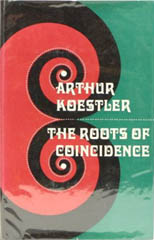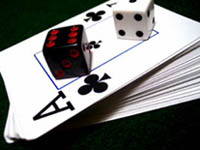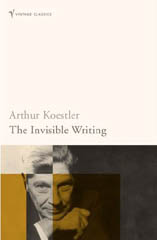I have a strange feeling about this
 Telepathy, precognition and psychokinesis – which may or may not even exist – are the subject of study at the Parapsychology Unit of Edinburgh University, established in 1985 as a result of a bequest from Arthur and Cynthia Koestler, to foster research into ‘the capacity attributed to some individuals to interact with their environment by means other than the recognised sensory and motor channels’.
Telepathy, precognition and psychokinesis – which may or may not even exist – are the subject of study at the Parapsychology Unit of Edinburgh University, established in 1985 as a result of a bequest from Arthur and Cynthia Koestler, to foster research into ‘the capacity attributed to some individuals to interact with their environment by means other than the recognised sensory and motor channels’.
Part of scientific truth relies on an experiment being able to be replicated anywhere by anyone under broadly similar conditions and achieving the same result. So what the Parapsychology Unit researchers do relies not at all on birds’ entrails and drops of ink in bowls of water, but rather on computers and random number generators.
Therefore, they are trying to apply scientific method to something which may not even exist. Some of the random number experiments are hard to quantify; I am so much a non-statistician that I cannot advance any defence of the significance or otherwise of an occurrence being x% more than chance and even worse what thehance is that that 0s chance or otherwise. A telekinesis experiment, for example, attempts to establishwhether a subject can, by sheer concentration, influence a random number generators to produce a significant number of 1s rather than 0s.
The Unit, which pursues ‘the study of apparent new means of communication, or exchange of influence, between organisms and environment’, states on its website that, ‘if psi exists, it is likely to be an ability that is weakly but normally distributed in the general population. The people who take part in research are almost always just volunteers who do not profess to have any psi ability. Studies suggest that disbelievers in the paranormal (called ‘goats’) tend to perform less well in a psi task than believers (called ‘sheep’).
Rather sheepishly, I became a volunteer subject.
The first thing I noticed, naturally, was the Unit’s reassuring mundaneness and utter lack of stuffed crocodiles and alembics. I then spoke to a researcher and agreed that, yes, I came from a background which possibly predisposed me to believing in the apparently inexplicable.
One of the tests involved sitting in a room separate from the researcher who dealt himself symbol cards; I had to identify them as pleasant images or otherwise. I vividly remember identifying a card as a picture of the MP Norman Tebbit, when it was a skull with worms appearing from the eye sockets! That caused some amusement and got me an explanation of something called ‘perceptual defensiveness’, where the brain is so displeased by what it sees that it wipes the memory before it registers. (Oddly enough, this was borne out many months later, when, as part of a market research project for cold remedies, I was shown several film clips which included a traffic warden sneezing without covering her mouth.At the end of the session I could describe every other clip in the sequence in quite inordinate detail, but did not remember the traffic warden at all.)
 At the Parapsychology Unit I was also shown a series of clips of someone talking directly to camera while performing card tricks; I had to specify whether or not he was cheating and/or lying. To my consternation, in one instance I said he was lying but could not justify why I thought that, except -and I quote myself – ‘He may have been giving a non-verbal clue.’ When I saw the film again, the non-verbal clue was in fact that the speaker was writing the truthful answer, in plain sight, on a pad of paper on the table in front of him! I clearly scored no marks for observation, but received a possible hint of some intuition.
At the Parapsychology Unit I was also shown a series of clips of someone talking directly to camera while performing card tricks; I had to specify whether or not he was cheating and/or lying. To my consternation, in one instance I said he was lying but could not justify why I thought that, except -and I quote myself – ‘He may have been giving a non-verbal clue.’ When I saw the film again, the non-verbal clue was in fact that the speaker was writing the truthful answer, in plain sight, on a pad of paper on the table in front of him! I clearly scored no marks for observation, but received a possible hint of some intuition.
And this is where it becomes difficult: what is intuition? Is it simply an unconscious putting together of apparently unremarkable clues until they cumulatively present themselves as fact? Let me give you a somewhat embarrassing example. Once upon a time I was engaged to a vaguely glamorous and somewhat older man. We were staying with my parents while preparing for the wedding. One day I turned back on my way to work, threw up, went home and explained what had happened.
The next day, I went to work, felt terrible during the afternoon, went home, and, according to my mother, walked upstairs on auto-pilot into my fiancé’s room – where I discovered an empty wardrobe, no luggage, and no note. It was weeks before it dawned on me that he presumably thought I was pregnant and had skipped the countrybefore the point of no return was reached.
Then the bills started arriving, cheques bounced and people came calling at the house looking for him. The weeks leading up to the cancelled wedding were a nightmare, and it was a sudden realisation of something I had ignored that caused me to have a re-think. The whole time we had been dating, then living together, then engaged, I had suffered vicious migraines, and only when this crisis blew up did they stop. From three or four migraines a week, I have now had approximately one a decade ever since.
I have had negative intuitions about people, that have proved accurate but which I can’t attribute to my own powers of observation. Although I do have a highly-trained memory, when I returned to Britain from New Zealand, it took me five years to notice that the number plate on the front of a car is a different colour from the one at the back.
I don’t consider myself unusual in believing I might have a ‘sixth sense’. But few people are professionals in field, and whether there is any such thing at all remains contentious. One of the strongest advocates to argue for the validity of systematic research into all this was Arthur Koestler. Born in Hungary in 1905, he studied science and at the and became a professional writer and journalist. Perhaps best known for his social commentary, his enduring interest in the outer reaches of psychological manifestations led him to experiment with mind-altering substances such as mescalin. Like Carl Jung, he was fascinated by synchronicity, which he investigates in The Roots of Coincidence, (1972). As Fortean Times journalist Paul Devereux explains:
He proceeds to seek the roots of coincidence in the Alice-in-Wonderland world of quantum physics, the infinitesimally small subatomic realm where our everyday logic no longer holds sway, where particles can be waves and vice versa, where forces that only mathematical equations can glimpse swim in the dark, unfathomable ocean of probability before the manifestation of either matter or mind. Towards the end of the book, Koestler pleads that parapsychology be made ‘academically respectable and attractive to students’, otherwise the ‘limitations of our biological equipment may condemn us to the role of Peeping Toms at the keyhole of eternity’.
 Koestler’s quiet interest in the paranormal probably stemmed from a mystical experience he had at the age of fourteen. Other such mystical moments befell him at various points in his life… he recalls in The Invisible Writing (1954), he underwent an experience in which he felt as if he were floating on ‘a river of peace, under bridges of silence’. Eventually, ‘there was no river and no I’; there was a sense of dissolution and of limitless expansion.
Koestler’s quiet interest in the paranormal probably stemmed from a mystical experience he had at the age of fourteen. Other such mystical moments befell him at various points in his life… he recalls in The Invisible Writing (1954), he underwent an experience in which he felt as if he were floating on ‘a river of peace, under bridges of silence’. Eventually, ‘there was no river and no I’; there was a sense of dissolution and of limitless expansion.
Looking back on my visit to the Parapsychology Unit, I can say one thing with certainty: I found it interesting. The systematic research techniques applied there offer the possibility of identifying and perhaps understanding actual but elusive phenomena. That there are more things in heaven and earth than are dreamt of in our philosophy, is indeed something more than the ghost of an idea
…
© Fiona Allen
Paul Devereux’s Fortean Times articles:
Parapsychology Unit of Edinburgh University

Comments